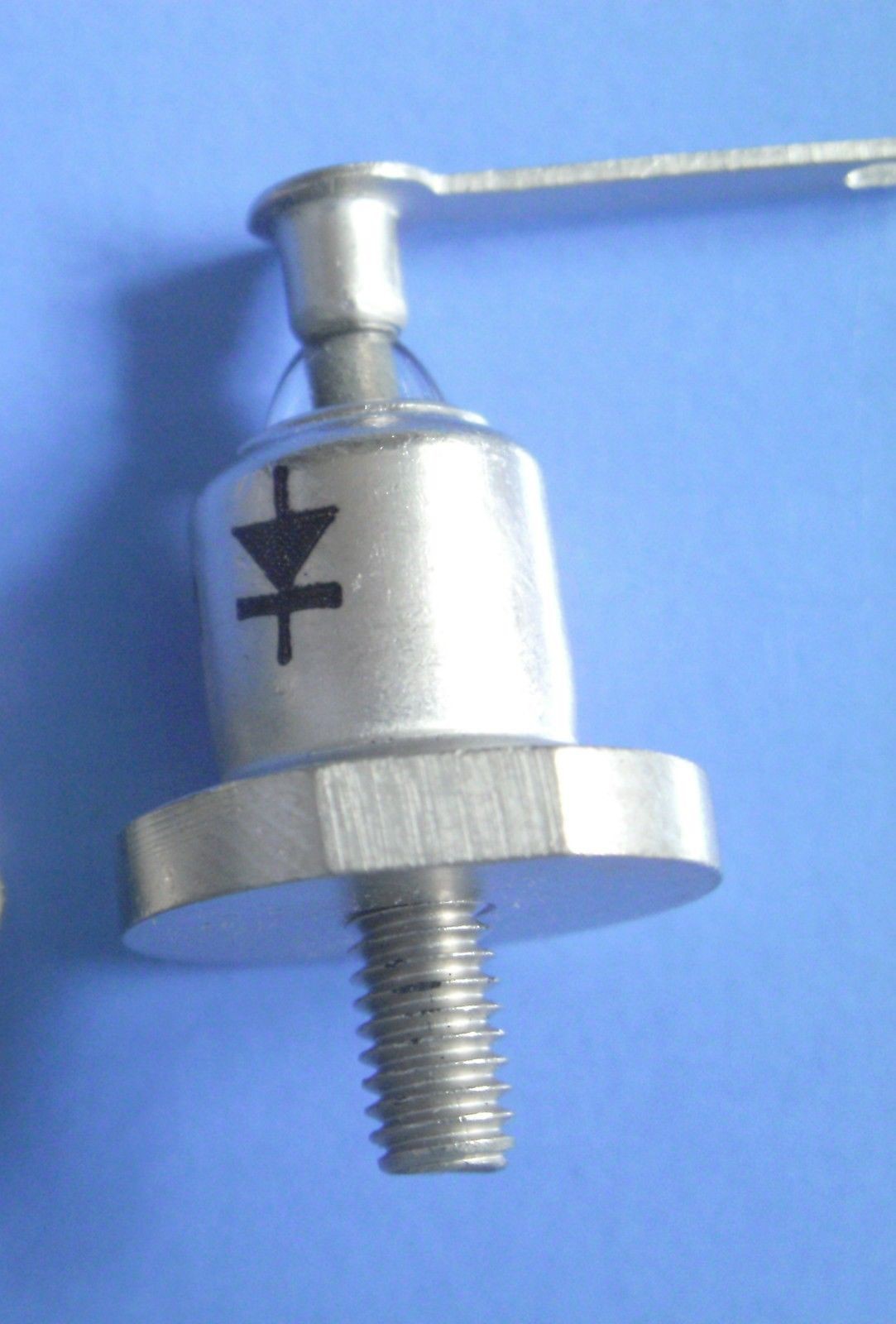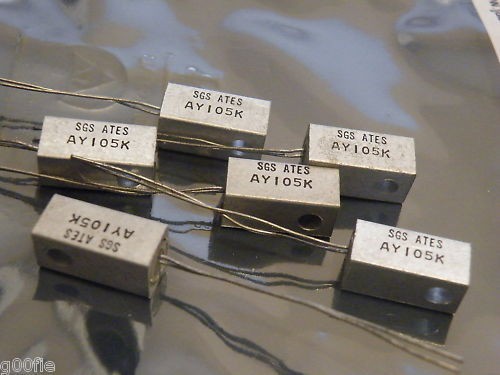So far I have only played with nimble, fragile, low-current, point-contact germanium diodes. The "neovintage" power supply of the register set requires higher current than their usual 20 to 40mA rating.

I got some OA31 from the usual suspect (minifux1) (who provided, among others, essential parts for #Germanium ECL) and they are pretty impressive: rated at 85V reverse voltage, or 3.8A in direct current. Germanium hates the heat (it leaks a lot and the junction should not exceed 85°C usually) so the bulky metal package says we're doing serious business here.
I measured the I/V curve with a crude setup and I'm rather impressed :-)
| Direct current (A) | Voltage drop (V) |
| 0.05 | 0.24 |
| 0.1 | 0.29 |
| 0.15 | 0.31 |
| 0.2 | 0.33 |
| 0.25 | 0.35 |
| 0.3 | 0.34 |
| 0.35 | 0.35 |
| 0.4 | 0.36 |
| 0.45 | 0.36 |
| 0.5 | 0.37 |
| 0.55 | 0.38 |
| 0.6 | 0.38 |
| 0.7 | 0.4 |
| 0.8 | 0.4 |
| 0.9 | 0.4 |
| 1 | 0.4 |
| 1.2 | 0.41 |
| 1.5 | 0.43 |
| 2 | 0.45 |
The curve is quite flat and the drop is lower than silicon diodes and comparable to a good Schottky ! This is a significant progress compared to selenium rectifiers ;-) and the performance for the low-voltage diode bridge will be great :-)
I expect a Vpeak of 4.3V at the output of the transformer (conservative estimate). The diode bridge will "eat" 2×0.45V=0.9V, make this 1V. The diode bridge peak will be at least 3.3V, better than the previous estimate of 2.9V :-)
These measurements were done "cold" and are expected to vary with temperature. Not in a bad way, though, because the drop would be slightly reduced. I don't expect the diodes to require a heatsink because they would dissipate an average of 0.5W and they are already pretty bulky.
As previously noted, this could be tested with loads made of many 39 ohms resistors in parallel.
But wait, I also received several AY105K ! They are a little bit smaller and are rated for 5A (a different source claims 3A, which is a convenient margin)

It's another contender for the diode bridges. Those vintage Italian diodes are smaller and have a more convenient packaging with insulated heat spreader !
However the drop is higher than the OC31 : 0.5V at 1A only, and 0.59V at 1.5A. I would use them for the other power supplies, where the rails are higher voltage (12V ?) and slightly lower current.
I also expect to receive a few Д305 for comparison. They are claimed at 10A so they should be impressive, though I won't have enough to make more than one bridge. So far the OA31 is the clear winner :-)
 Yann Guidon / YGDES
Yann Guidon / YGDES
Discussions
Become a Hackaday.io Member
Create an account to leave a comment. Already have an account? Log In.
Voltage drop really impressed! I'm thinking about replacing my Silicon diodes D226 in relay computer to germanium, but currently haven't enough number of D7 diodes.
but everything works fine right now, if you will not connect two and more silicon diodes together.
Are you sure? yes | no
can you explain how you use these diodes and why it makes a difference ?
is it for switching signals or for the power supply ?
Are you sure? yes | no
With 5V power supply if you use more than two silicon diodes with reed relay, the last one would have not enough voltage to work.
So I'm using diodes as OR logical element to speedup control logic of my PC. And add only one diode-based OR element between relay coil and power line.
Are you sure? yes | no
Efficient Germanium diodes might not be cost-effective. Here I study the feasibility of using germanium for the power supply itself, there are not many diodes. But for logic you need more smaller diodes and the cheap point-contact diodes have a low current limit, too low for driving a relay coil.
Did you try Schottky diodes ? Some low-voltage ones have a very low drop at reasonable price for medium current.
Are you sure? yes | no
You have to love a diode with a heatsink mount!
Are you sure? yes | no
well, YOU are the diode fetishist here, while I'm only trying to prevent it from overheating ;-)
Are you sure? yes | no
OMG, I would never actually *use* a beauty like that!
Are you sure? yes | no
Why ? what would be the point ? I don't buy stuff for the pleasure of seeing it collect dust :-D
Are you sure? yes | no
OMG, I would never let it get dusty, either!
:-P
Are you sure? yes | no
So what would you do ? :-D
Are you sure? yes | no
I'd find them on ebay, think of some project that needed them, and buy them late one night. By the time they arrived, I'd have either forgotten about the project or realized I don't have the time/money/parts to complete it at the moment. The diodes would end up at the bottom of a box. Ten years later, in the middle of another project they'd be *perfect* for, I'd find them again, but decide not to use them because they were purchased with something else in mind - even though I can no longer remember what it was.
I have a lot of parts.
Are you sure? yes | no